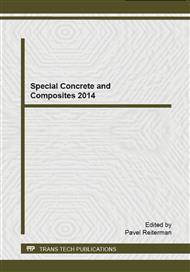p.188
p.194
p.199
p.205
p.209
p.215
p.221
p.227
p.234
Influence of PCM Admixture on Thermal Behavior of Composite Plaster
Abstract:
Experimental investigation of the effect of phase change material (PCM) admixture on thermal properties of composite plaster is researched in the paper. Due to its latent heat storage, the applied PCM represents promising way for reduction of buildings energy consumption spent for heating and air conditioning. The investigated composite material is based on commercial dry plaster mixture modified by microencapsulated PCM admixture Micronal DS 5038 produced BASF. The particle size distribution of PCM admixture, original dry plaster mixture, and particular dry mixture with PCM addition are measured on laser diffraction principle. For characterization of the developed materials, measurement of their basic physical properties is done. Specific attention is paid to thermal properties of research materials, whereas the heat transport parameters are measured using transient impulse device, and the DSC (difference scanning calorimetry) analysis is applied for determination of temperatures of phase transitions, enthalpy of fusion and crystallization, and temperature dependent specific heat capacity. The obtained results show significant improvement of the heat storage capacity of PCM modified plasters in dependence on temperature, what can be beneficially used for regulation of the indoor climate.
Info:
Periodical:
Pages:
209-214
Citation:
Online since:
October 2014
Authors:
Price:
Сopyright:
© 2014 Trans Tech Publications Ltd. All Rights Reserved
Share:
Citation:


